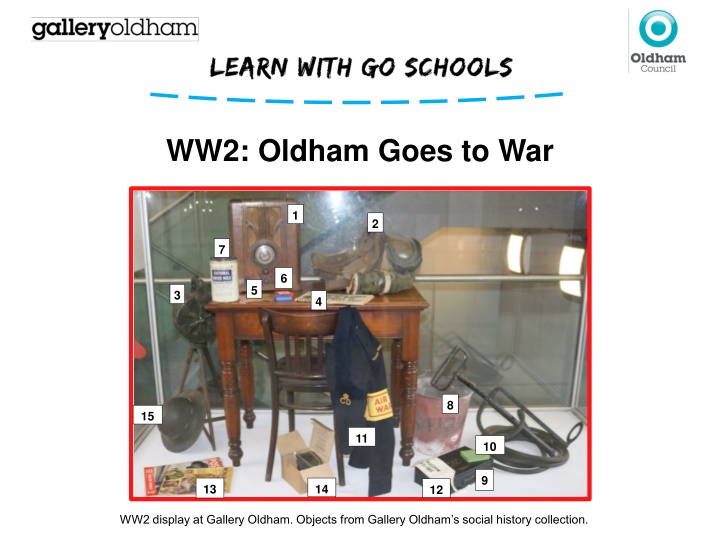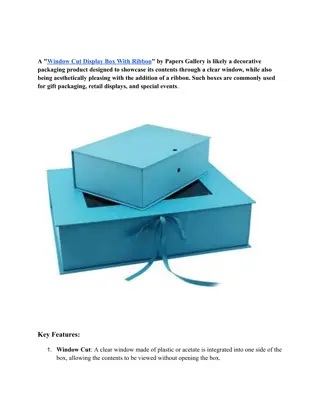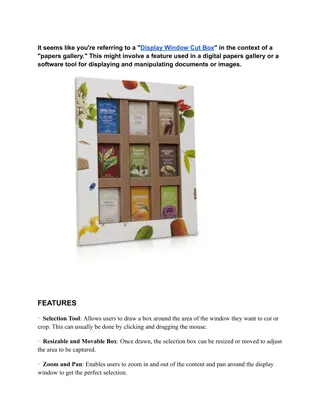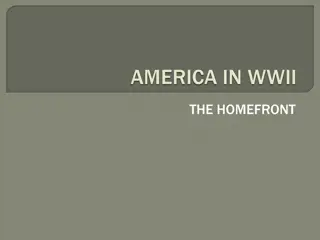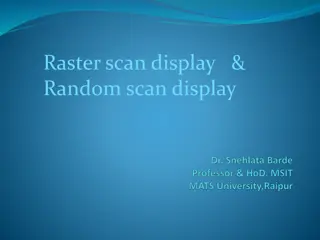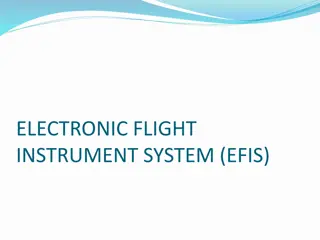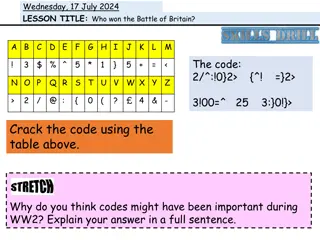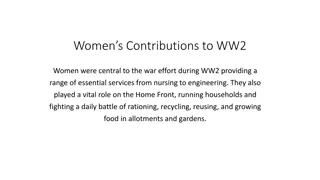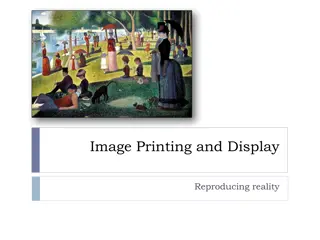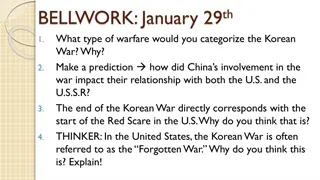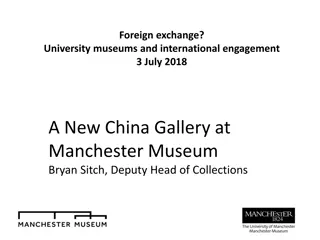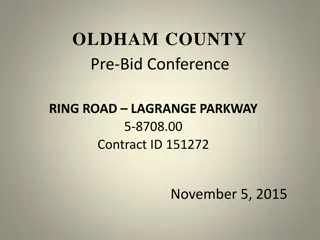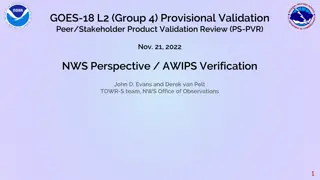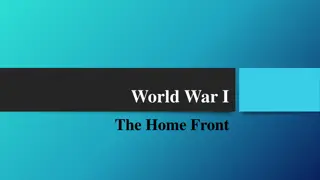WW2: Oldham Goes to War Display at Gallery Oldham
"Explore the WW2 display at Gallery Oldham showcasing objects from the social history collection, including a radio set, air raid siren, infant respirator, ration books, powdered milk tin, ARP insignia badges, and more. Discover how these artifacts played a crucial role during wartime, from maintaining security to boosting morale and protecting citizens."
Download Presentation

Please find below an Image/Link to download the presentation.
The content on the website is provided AS IS for your information and personal use only. It may not be sold, licensed, or shared on other websites without obtaining consent from the author.If you encounter any issues during the download, it is possible that the publisher has removed the file from their server.
You are allowed to download the files provided on this website for personal or commercial use, subject to the condition that they are used lawfully. All files are the property of their respective owners.
The content on the website is provided AS IS for your information and personal use only. It may not be sold, licensed, or shared on other websites without obtaining consent from the author.
E N D
Presentation Transcript
WW2: Oldham Goes to War 1 2 7 6 5 3 4 8 15 11 10 9 13 14 12 WW2 display at Gallery Oldham. Objects from Gallery Oldham s social history collection.
1. RADIO SET On September 3rd 1939 Prime Minister Neville Chamberlain broadcast to the Nation that war had been declared on Germany. In wartime, a radio set was vital for hearing news and information. It also provided entertainment to boost morale and help people forget their troubles. was close to home. 3. AIR RAID SIREN Sirens sounded a rising and falling howl when an air raid was about to happen. They warned people to head for the nearest air raid shelter. One long blast sounded the all clear when the air raid was over. 2. INFANT RESPIRATOR Babies were issued with gas masks with a steel helmet and a canvas "tent" that enclosed them. Before the war there was widespread fear that the Germans would attack British cities with poison gas bombs. Although gas was never used, carrying a gas mask at all times helped remind people that war 4. NEWSPAPER (replica) In wartime the government controlled or censored what newspapers printed. They did not want stories of how the war was being fought to cause public alarm or give too much away to the enemy. As the war progressed the number of pages in the papers dwindled as paper was in short supply.
5. RATION BOOKS AND IDENTITY CARD To maximise the war effort and maintain security, the wartime government took more control over how people lived their lives. British citizens had to register their details with the authorities and carry an identity card at all times. People with foreign passports were viewed as potential enemies and imprisoned in camps. Strict rationing was also introduced to prevent food shortages. The public were given ration books with coupons to exchange for goods. the home front from bombing raids in what became known as the Blitz . Air Raid Wardens enforced black-outs, stopping enemy planes from spotting targets lit up on the ground. The ARP also helped people to find air raid shelters, watched for fire bombs and rescued people from bombed buildings. 7. POWDERED MILK TIN In 1939 Britain imported about 60% of its food. Imported and even home-grown food became scarce as the war progressed and rationing increased. Ships bringing in goods were frequently sunk and remaining supplies were needed to help the war effort. From 1941 families were allowed 3 pints of fresh milk per 6. ARP INSIGNIA BADGES The ARP (Air Raid Precautions), refers to services set up to protect
9. ARP FIRST AID KIT During the blitz, many companies produced ARP first aid kits to help people cope with injuries received during air raids. They were used by families and Air Raid Wardens. This is a typical first aid box made by the company Boots, who still have high street shops today. Just being out in the blackout was dangerous because people could not see where they were going. Between 1939 and 1940 road accidents almost doubled in number. week, and one tin of powdered milk (said to be equal to four pints) per month. Children under two were also entitled to full- cream National Dried Milk with added vitamin D. 8. STIRRUP PUMP AND FIRE BUCKET As well as explosives, the enemy dropped fire bombs to set light to buildings below. Although small, they caused immense damage as they were filled with chemicals and burned for up to ten minutes. Working in teams of two or three, often stationed on rooftops, ARP fire watchers and wardens used their buckets and stirrup pumps to pump water onto the bombs until they were safely out. 10. ANTI GAS OINTMENT Tins of anti-gas ointment were distributed widely before and during the war. It was anticipated that mustard gas, used in the trenches with devastating effect
the Civil Defence Badge, Oldham Area. during the First World War, might be used once more. The ointment came in tubes to be applied to blisters on the skin. 12. SHELTER WARDEN ARMBAND Air raid shelters came in all shapes and sizes. If you had a garden you could build an Anderson shelter , made of corrugated iron. Some streets had their own communal shelters and most workplaces had adapted basements or outdoor shelters in case of day-time raids. In London, deep Underground stations were opened at night, allowing thousands to shelter from some of the worst raids of the Blitz. 11. CIVIL DEFENCE JACKET In 1941 the ARP was renamed the Civil Defence (CD) Service. This was thought to better reflect the widening number of roles its volunteer men and women performed. These included fire and rescue work, medical assistance and welfare for those made homeless by bombing. The jacket, made of wool serge, is a civilian variation of the standard short battledress tunic worn by most British servicemen from the 1930s until the 1960s. The left breast pocket features 13. MAGAZINES Like newspapers and the radio, magazines had a vital part to play
Zealand made a large batch of helmets for Britain as the British government could not satisfy demand. in spreading information and keeping up people s spirits. One of the most famous magazines of the time was Picture Post, which first appeared in 1938. In an age with no television or internet it was a way of bringing images of the war to everybody. 15. GAS MASK By the time war was declared in September 1939 no less than 38 million gas masks had been issued in Britain. This is one of the most common civilian masks and can be seen in its original box, complete with instructions. From the outbreak of war it was compulsory for people to carry a gas mask at all times. Fines were issued if you were caught without it. The flimsy cardboard boxes tended to fall apart so, overtime, people bought or made their own personalised cases or handbags. 14. HELMET This fire watcher s helmet is based on the standard British Brodie type helmet which was first introduced in 1915. Millions of the broad brimmed helmet were made over the next thirty years and worn by troops and civilian workers in the Second World War. The shape of this one suggests it may have been made in New Zealand. At the beginning of the war New
ACTIVITY: FURTHER RESEARCH: Write a letter to a loved one during wartime. Describe how the war is affecting Oldham and Oldhamers on the Home Front . Refer to some of the objects featured in this resource in your letter! Learn about the outbreak of WW2 here. Discover more about the wartime experience online here, where you can also learn about rationing and the Blitz. Read about an Oldhamer s war experience here. Discover the WW2 materials held by Oldham Local Studies & Archives here and Gallery Oldham here. SAFETY NOTE: Real gas masks and bags should not be worn or handled today as they contain the dangerous chemical asbestos. They did not realise this in WW2. Share your letters via librariesandgalleryschools@oldham.gov.uk or social media: Gallery Oldham @GalleryOldham @galleryoldham
